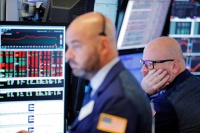U.S. stock futures fall after Trump announces new round of tariffs

By Stephen Culp
NEW YORK (Reuters) - U.S. stock index futures extended losses in post-market trading late Monday after President Trump announced a new round of tariffs on about $200 billion worth of Chinese imports.
Trump said he will impose 10 percent U.S. tariffs on about $200 billion worth of Chinese imports but he spared smart watches from Apple (NASDAQ: AAPL) and Fitbit (NYSE: FIT).
S&P 500 e-mini futures
Trump also warned that if China takes retaliatory action against U.S. farmers and industries, the administration will pursue tariffs on about $267 billion of additional imports.
Earlier, U.S. stocks closed lower on Monday, led by declines in technology and consumer discretionary stocks ahead of President Donald Trump's announcement regarding tariffs on $200 billion of Chinese imports.
"Although this was expected and we sold off before the close, one would think the market should be down more," said Michael O'Rourke, chief market strategist at JonesTrading in Greenwich, Connecticut.
"It's at the point, the larger these tariffs become, the bigger the problem they become for the administration and the United States. It ups the ante in a significant way, as far as you're starting to cut some muscle. Consumers will start feeling it."
Earlier, China vowed that it will not play defense in the escalating trade dispute, adding further fuel to tensions as a new list of items subject to tariffs, including technology and consumer goods, was anticipated from Washington.
"This is the sixth or seventh time we talked about this particular round of tariffs," said Paul Nolte, portfolio manager at Kingsview Asset Management in Chicago. "As long as Trump is comfortable raising tariffs, he believes he's winning."
Consumer discretionary <.SPLRCD> and technology <.SPLRCT> were the biggest percentage losers on the S&P 500 index during the regular session, falling 1.3 percent and 1.4 percent, respectively.
Amazon.com (NASDAQ: AMZN) led consumer discretionary stocks lower, falling 3.2 percent.
Apple Inc (NASDAQ: AAPL) has said the moves could hit a "wide range" of its products. The iPhone maker's shares were down 2.7 percent, providing the biggest drag on the Dow, despite earlier reports that the United States would spare some of its products in the latest round of tariff actions.
All of the so-called FAANG group of momentum stocks closed down between 1.0 percent and 3.9 percent. Other FAANG stocks include Netflix (NASDAQ: NFLX), Facebook (NASDAQ: FB) and Google-parent Alphabet (NASDAQ: GOOGL).
"(The FAANG stocks have) had great runs; the fact that they'd come off a little bit really doesn't detract from the fact that they've put in some very good performance numbers this year," Nolte said. But he noted "investors might be slowly looking outside of tech for the next opportunity."
The Dow Jones Industrial Average <.DJI> fell 92.55 points, or 0.35 percent, to 26,062.12, the S&P 500 <.SPX> lost 16.18 points, or 0.56 percent, to 2,888.8 and the Nasdaq Composite <.IXIC> dropped 114.25 points, or 1.43 percent, to 7,895.79.
All three major U.S. indexes were lower, with the tech-heavy Nasdaq posting its biggest percentage loss since late July.
The S&P 500's slide was concentrated. Of the 11 major sectors in the index, only four ended the session in negative territory.
The CBOE Volatility index <.VIX>, a gauge of investor anxiety, rose 1.54 points, its first increase in six sessions.
Retailers, including Macy's Inc (NYSE: M) and Kohls Corp (NYSE: KSS), dropped, helping pull the S&P 500 retailers index <.SPXRT> 2.1 percent lower.
Twitter (NYSE: TWTR) fell 4.2 percent, the biggest percentage loser in the S&P 500 technology index, after brokerage MoffettNathanson flagged concerns over rising expenses.
Declining issues outnumbered advancing ones on the NYSE by a 1.46-to-1 ratio; on Nasdaq, a 2.12-to-1 ratio favored decliners.
The S&P 500 posted 34 new 52-week highs and 3 new lows; the Nasdaq Composite recorded 51 new highs and 90 new lows.
Volume on U.S. exchanges was 6.21 billion shares, compared with the 6.14 billion average over the last 20 trading days.
(Reporting by Stephen Culp; additional reporting by Caroline Valetkevitch; Editing by Clive McKeef)
